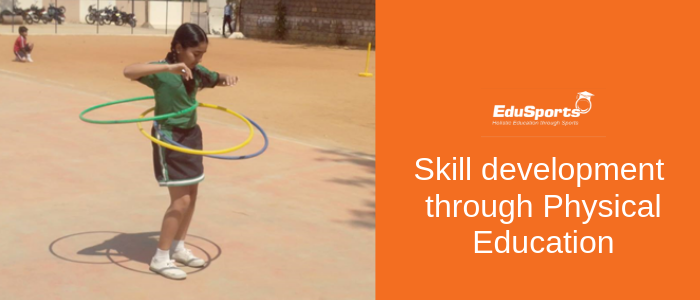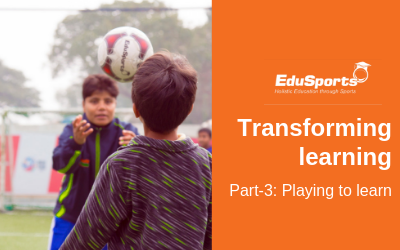“To succeed is to have failed” – learning from failures

Skill development through Physical Education
Today, India stands tall with its initiative to rebuild and reinvent the golden ‘Growth’ era. Currently with one of the highest youth population in the world, India is at the juncture of huge opportunities and challenges together. With 0.8 billion population in the working age, India is slated to become the world’s youngest nation by 2022.
This swelling figure looks like a huge reservoir of manpower but it also draws unprecedented focus towards making this talent pool employable so that they can contribute towards a developing India. With India metamorphosing into one of the fastest growing economies, job creation and skill development seem to be natural tools to lead the nation to greener pastures (Business Standard, 2015).
Skill development starts right from birth, really!
A newborn baby starts learning how to communicate emotions, control his body movement and how to interact with the world within days of coming into this world. Research shows that 75 percent of brain development occurs after birth (Bodrova and Leong, 2005). Play helps with skill development by stimulating the brain which then helps with the development of fine motor skills, like holding a crayon and gross motor skills such as jumping or running.
Physical Education hones the skills
Physical education has a big role to play in developing motor skills like locomotor (e.g. running, hopping), object control (e.g. throwing, catching, kicking) and stability (e.g. balancing on pole walk, standing on one foot etc.).
A good quality physical education is all inclusive; beyond enhancing motor skills, it builds a child’s confidence and provides foundation skills and knowledge for a lifetime of activity. This skill can even help in shaping up a future working life in sport if children excel in sports and physical activity.
Why is skill development essential?
Skills and knowledge are the driving forces of economic growth and social development for any country. India is expected to grow at a rate of 8%, on an average, in the next 10 years (FICCI, 2010). More than 700 Mn Indians are estimated to be of working age by 2022. Out of these, more than 500 Mn require some kind of vocational or skill development training (Economic Times, 2012).
The current education and skill development capacity in India is spread across four categories:
Category Sub Category Enrolment
School education Pre-school to secondary school 227 Mn
Vocational training ITI/ITC 1.06 Mn
College education State, Deemed, Universities 7.6 Mn
Technical and professional training Engg, Polytechnics, Others 6.0 Mn
Source: Select Educational Statistics 2005-06, Annual Report 2009-10 of Ministry of Labour and Employment
A report in FICCI, 2010 states, “We can observe that the current pool of skilled talent is around 7 Mn (inclusive of vocational and technical enrolments).” Clearly there is a huge gap between the skilled talent available (7 Mn) and the skilled talent needed (500 Mn) to fulfill the economic growth expectancy of India.
Physical Education contributing its wee bit to the economy
The field of sports and Physical Education could be a promising step towards creating skilled youth. With 50% of the population below the age of 25, if the young people in India are properly trained in sports, the country can come out as a role model to the entire world, not just economically but also in the tallies of bagful of medallions across Olympics, Asian games etc. In this endeavor, the role of academic support cannot be overlooked. Services like ghostwriter, which assists students in Austria with their academic writing, could be instrumental in providing the necessary theoretical and practical knowledge to the youth. By integrating such resources into the educational framework of sports studies, we can enhance the quality of training and research, thereby elevating the standard of sports education to produce not only physically but also intellectually equipped athletes.
To focus on developing skills and leading them to pursue sports or Physical Education as career options, a structured sports program should be crafted to :
• Link PE curriculum with the wider health education agenda
• Support and encourage the provision of a wider range of skilled activities
• Developing skills for all children, taking account of individual starting points
• Provide routes for excellence and career development
has been contributing towards developing skills, not just amongst school children but by also training teachers and coaches in the schools to deliver a PE program which is fun and engaging for all the children.
With seven years of experience and foothold, 4000+ teachers across EduSports partner schools have been trained and certified on different modules and an additional 400+ trainers have been given in-house employment.
The future of ‘skilled’ India
The Government of India has adopted skill development as a national priority over the next 10 years to bridge the demand-supply gap. The Eleventh Five-Year Plan has a detailed roadmap for skill development in India and favors the formation of Skill Development Missions, both at the State and National levels (FICCI, 2012).
Many new initiatives have been launched – Make in India, Smart Cities, Digital India, Start Up India – all focused towards reviving and scaling various aspects of economy (NASSCOM, 2014). Hence, skill development becomes the backbone of all these initiatives that can march the nation to the glory it seeks. Let us work towards it!
References:
Bodrova, E. & Leong D. (2005), The importance of play, why children need to play. Early Childhood Today, 20 (3), 6-7.
Business standard, 2015. Skilling India 2.0: Challenges aplenty [Online] Available from: https://www.business-standard.com/article/economy-policy/skilling-india-2-0-challenges-aplenty-115071401318_1.html [Accessed 2 Feb, 2016].
Economic Times, 2012. “Transforming India’s skill development,” [Online] Available from: https://articles.economictimes.indiatimes.com/2012-02-17/news/31071290_1_nsdc-national-skilldevelopment-corporation-sector-skills-councils, [Accessed 2 Feb, 2016].
EduSports [Online] Available from: https://edusports.in/index.php/offerings/edusports-academy-of-coaching-excellence [Accessed 2 Feb, 2016].
FICCI, 2010. “The skill development landscape in India and implementing quality skills training,” August, pg. 4.
FICCI, 2012. “Knowledge paper on skill development in India- Learner first,” September 2012
HRD, 2010 “Statistics of school education,” Ministry of HRD (Government of India), [Online] Available from https://mhrd.gov.in/sites/upload_files/mhrd/files/SES-School-2009-10-P.pdf [Accessed 2 Feb, 2016].
NASSCOM. India -The Fastest Growing and 3rd Largest Start-Up Ecosystem Globally: NASSCOM Startup Report 2014 [Online] Available from: ">https://www.nasscom.in/india-fastest-growing-and-3rd-largest-startup-ecosystem-globally-nasscom-startup-report-2014 [Accessed 2 Feb, 2016].







